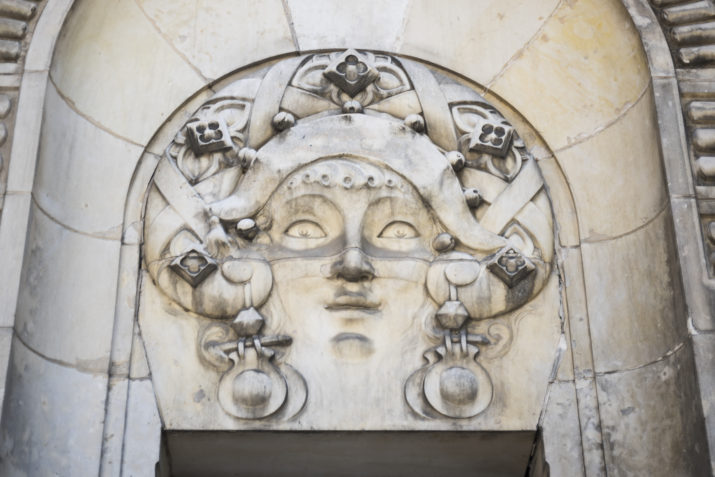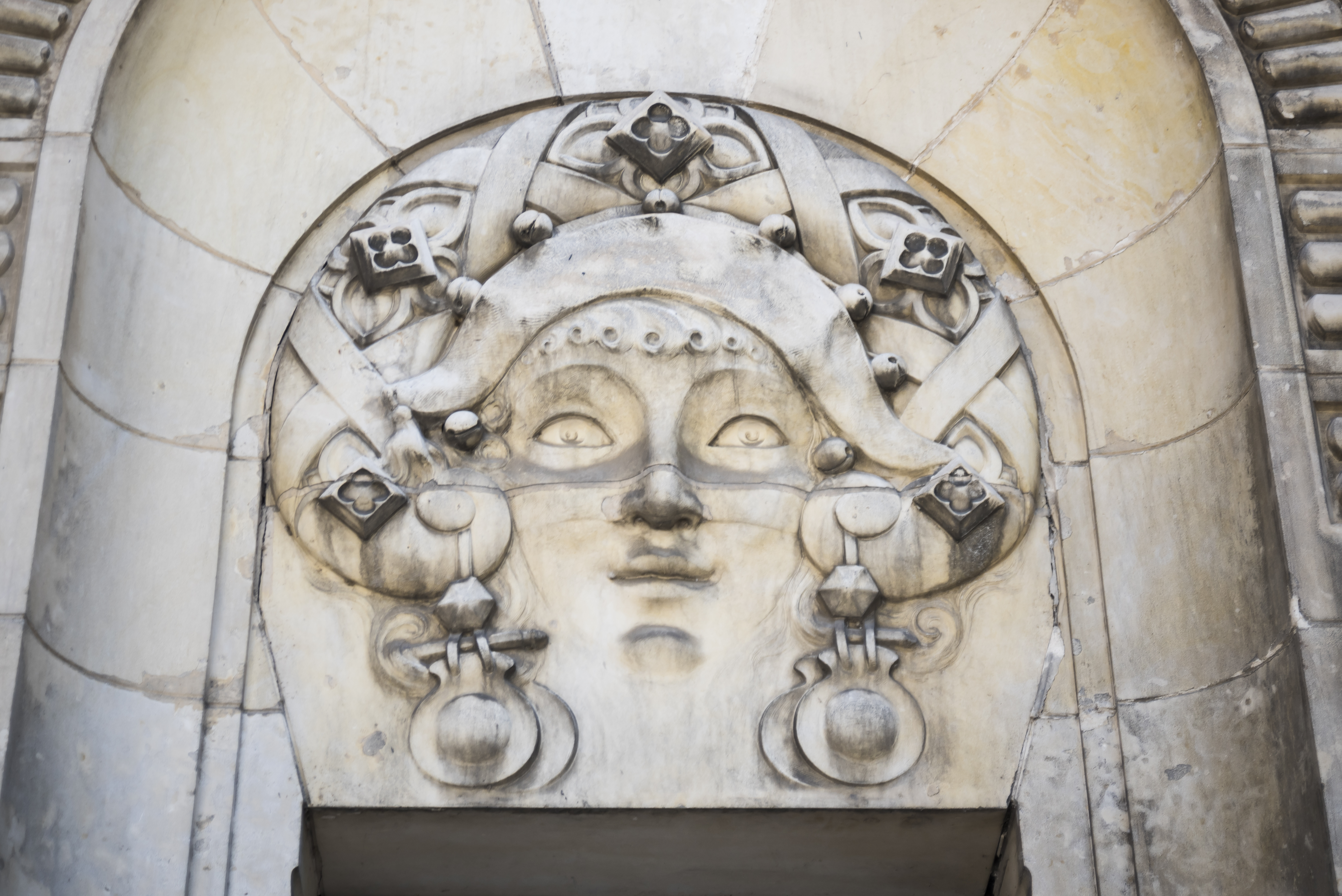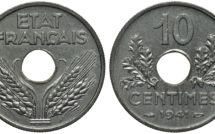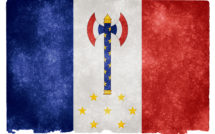

This is part of a roundtable, Author-Meets-Critics: Vichy contre Vichy, Une capitale sans mémoire by Audrey Mallet
The visitor to Vichy today will look in vain for the Hôtel du Parc, seat of Marshal Pétain’s government from 1940 to 1944. The building still exists. But there are no signs to indicate its former incarnation. It is now a block of offices, apartments, shops and the local tourist office, where an official will tell you—on request—that, yes, this was the site of the Hôtel du Parc. The only sign of the building’s association with the defunct regime is closed to the casual tourist. It is the commemorative plaque inside, next to the door to the marshal’s apartment, a plaque paid for by the Association pour défendre la mémoire du maréchal Pétain. The history of the town leading to the almost ubiquitous absence today of public references to the regime is the theme of Audrey Mallet’s subtle, absorbing and elegantly written book, Vichy contre Vichy: Une capitale sans mémoire. In it, she explains the reasons for the “local silence,” in contrast with the “national obsession” with the Vichy regime, analyzed notably by Henry Rousso and others.[1]
Why this local silence in Vichy about its wartime past? Mallet’s book provides the answer by tracing the efforts of the different local protagonists—maréchalistes, resisters, officials, elected representatives, pieds-noirs and ordinary Vichyssois—to deal with what they complained was the stigma of the Vichy regime’s repression and collaboration with the enemy, a stigma apparently inflicted on the town by the rest of France after the war. In the eyes of the Vichyssois, Vichy the town was erroneously conflated by their compatriots with Vichy the regime. As a result, so the Vichyssois alleged, the town’s reputation suffered, contributing to the post-war decline of the jewel in the crown of the local economy, the water cures offered by this self-proclaimed “queen of spas.” Vichyssoise by origin, Mallet briefly recalls the rise of the health resort to become by 1939 the “capitale mondiale du thermalisme.” She has mined local and national archives, as well as interviewed local inhabitants, to give us the story of “Vichy’s response to Vichy” after the war. She guides us adeptly through the twists and turns of Vichy’s remembering and forgetting and highlights the challenges of dealing with the past. Mallet is not the first historian to tackle the subject of the town’s war-time history. A fine study on daily life at the time was written by Michèle Cointet in 1993.[2] Local historians also have written about Vichy’s dark years.[3] Although Mallet refers to them in her text, she indicates that their lack of source references calls into question the reliability of their work (255). The virtues of Mallet’s work are that it deals with the issue of memory and it skillfully and thoroughly weaves local and national history together, in order to probe the town’s struggle to come to terms with its wartime past—a struggle that is not yet over.
The presence in Vichy of Marshal Pétain and his ministers, the supporting civil servants and military authorities brought advantages to the local inhabitants. Indeed, at first, although some complained about the sudden arrival of so many outsiders, many Vichyssois welcomed the government, hoping that it would protect them against the cataclysm that had overwhelmed the country. By the autumn of 1940, the population of Vichy and its immediate surroundings had swollen to about 120,000, five times the size of the pre-war local population out of season (November to April). The government requisitioned the town’s numerous hotels to house its ministries, agencies and their staff. The hotels, which would normally be empty in winter, were now occupied by the newcomers, providing hotel-owners and employees with income, which they would otherwise not have received in winter (most hotels had no heating, so in winter civil servants had to battle against not only hunger but also the cold).[4] Some hotel-owners even managed to negotiate the price of letting their properties to the government. On the other hand, the town’s tourism had more or less collapsed. From the spring of 1940 health tourists were few and far between, despite the town’s efforts to regenerate the trade. The filling of hotels and buildings with officials and agency staff had beneficial knock-on effects on the local economy, although the local inhabitants who worked in the thermal cure centers no longer had jobs.
Like everywhere else in France, food was in short supply and rationed for ordinary people (Pétain, his ministers and their entourages continued to eat very well, however). The lack of adequate food became a major preoccupation for the town’s population, as records show. In order to suppress any potential public displays of discontent in the country’s “capital”—which would have reflected badly on the regime—the government made more of an effort to increase food supplies for the local population and to crack down on the black market. The net result, as Mallet mentions, was a less drastic deterioration in human health than elsewhere. She cites figures by Kirrily Freeman drawing on the study done in 1943 of local health conditions: a baby born in Vichy in 1943 weighed on average ten kilograms, compared to 8.8 kilos in other areas of France. Similarly, infant mortality rates in Vichy were lower (p. 39).[5] The government’s presence brought other compensations too. The large numbers of security personnel increased the personal safety of the local population. Moreover, from time to time, daily life in Vichy offered the distracting spectacles of the pomp and ceremony surrounding the marshal’s walkabouts, military parades, official ceremonies, charity and sporting events, entertainments, and the comings and goings of ministers, politicians, sportsmen, singers, film stars and other celebrities.
On the other hand, from as early as July 1940, the regime began to take repressive measures against individuals and minority groups, including suspect officials, judges, teachers, free-masons, Jews, communists and Gaullists. Many Jews were expelled from the town. Those remaining fell in number from several thousand in 1940 to about six-hundred in 1943 and a handful in 1944. The Jews of Vichy who were arrested and deported numbered 144. The presence of representatives of the German military and secret police from the end of 1940 onwards (even though Vichy was in the unoccupied zone of the country until November 1942) contributed to an atmosphere of increasing fear and repression. The climate of fear worsened as the war continued and the members of Darnand’s paramilitary Milice grew in number and acted more violently. Their victims were known to be tortured in the basement of the Petit Casino, the Gestapo’s victims in the Hôtel du Portugal.
In the face of intensifying hardship and terror, the majority of Vichyssois became attentistes, as in other parts of France.[6] Because of the local population’s economic dependence on the regime, according to Mallet, Vichyssois were less inclined to act. From the existing records it is difficult to know whether the few who became collaborationists or resisters were native Vichyssois or residents who had arrived since the start of the war. As for the municipality and its mayor, together with the Société des grands hôtels de Vichy and the Compagnie fermière (which ran the town’s thermal installations), they adopted an ambivalent attitude towards the regime and the Resistance. Mallet summarizes the attentisme of the majority of Vichy’s population as one of “acquiescence, accommodation and blindness” (86). Some supported the regime. Many aimed to please their guests in line with the town’s tradition of hospitality. And some were blinded by the courtesy and tact with which the important people in their midst treated the majority of the local population. It was not surprising that some Vichyssois doubted their important visitors were bad people. How could they be? This acquiescence, accommodation and blindness contributed to the attempt after the war to forget the dark years of 1940-44. Visitors to the town are struck by the reluctance of the present-day Vichyssois to talk about the war. For example, in his book The Algeria Hotel (venue of the Commissariat général aux questions juives), Adam Nossiter describes the Vichyssois’s claim that nothing really happened during the war in the town as “affirmations of an unrecoverable past … not statements of fact so much as a longing, an obscure but fervent wish for freedom, sometimes tinged with paradoxical nostalgia.”[7]
Vichy was liberated on August 26, 1944. Mallet examines in detail the local purge of collaborators (l’épuration). What was remarkable, she argues, was that the local population hoped that the arrest in Vichy of well-known figures of the regime, such as the anti-Semitic minister Xavier Vallat (the first head of the Commissariat général aux questions juives), would absolve the “true” Vichyssois of their guilt by association with the regime. They expected the épuration would confirm the town’s innocence. The fact that, for the local population, the purging of the guilty did not go far enough mutated curiously into a source of resentment against the rest of France, which in due course the Vichyssois came to accuse of “ostracizing” the town. In the immediate post-war period, local ceremonies were staged to demonstrate that Vichy had its heroes and martyrs and that they had resisted the enemy and the regime. These acts of memorialization conformed to the Gaullist narrative that, apart from a tiny minority of collaborators, France as a whole had resisted the enemy. But at the same time the municipality set about removing all physical traces on buildings and sites that could remind the visitor of the regime’s past presence in the town. Mallet plots this paradoxical desire of the Vichyssois to be part of the national narrative and yet, simultaneously, to distance itself on the pretext of rejecting the supposed national stigmatization of the town. Even today, the local historian Thierry Wirth dedicates his book Vichy Capitale 1940-1944 to “all the Vichyssois who are not Vichystes and who suffer to see the name of what was the ‘Queen of Spas’ soiled by ignorant people or manipulators of History.”[8] With the rapid recovery of spa tourism by the beginning of the 1950s, writes Mallet, it was time for the town “to turn its back on the memory of the war once and for all”, a turn which became a policy of “silence and memorial non-intervention”, pursued to this day by all of Vichy’s mayors, “making Vichy a site of non-memory of the Second World War” (162-167).
Mallet reminds us of another dimension to the story of non-remembering, namely the effects of the war of Algerian independence. Prior to both conflicts, the spa town had been among the favorite health centers in France frequented by colonial administrators and French inhabitants of North Africa on leave to be cured of tropical diseases (it was thought that a spa treatment could fight malaria). As the Algerian war raged, these same health tourists stopped coming and were lost to the town’s economy. The consequences were not only economic but also political, Mallet suggests. Whereas the Algerian war contributed to a more critical approach to remembering the Second World War nationally in France, in Vichy it had the reverse effect: it bolstered the local memory of Pétain, “essentially maréchaliste and underground”. There was already a small post-war, discreet bedrock of supporters of the marshal at Vichy, those who had been fortunate enough to face less material hardship and repression than the majority in 1940-44 (historians tend to distinguish between attachment to Pétain the man [maréchalisme] and attachment to the regime’s ideology [pétainisme]). Now the ultras of l’Algérie française, the pieds-noirs who came to settle in Vichy after the war of independence, claimed it was Pétain, and not de Gaulle, who had been the defender of the French empire. But, despite the resurgence of this “nostalgie maréchaliste”, the number of devotees was never enough to generate Pétain’s public idolization in the town. Conversely, the local weakness of the Left and the ambivalence of the municipality, which gave only limited support to the efforts of the associations of resisters, resulted in rare commemorations of the Resistance.
Mallet refers in passing to the issue of so-called “dark tourism,” the controversial exploitation of sites of historical suffering, destruction and death. She does not equate Vichy with sites such as Auschwitz-Birkenau. Rather, she believes that Vichy is “a site of difficult memory, which for a long time has aroused the curiosity and interest of French and foreign tourists” (219-220). The decline of spa tourism from the 1960s (the result of external factors such as increasing travel abroad) and the greater national attention directed at the Second World War in France since the 1980s have exacerbated Vichy’s crisis of identity and delayed a reconciliation with its past. Mallet goes into interesting detail about what she calls Vichy’s “architectural illusion”, the role of the many buildings of the Second Empire and Belle Epoque that provide a reassuring link to the past, blotting out the war years (220). But changes are afoot. In 2000, in the wake of the activities of Serge Klarsfeld in France and the greater worldwide emphasis placed by historians, survivor groups and others on the Shoah, a stele commemorating Vichy’s Jewish victims was erected opposite the former Hôtel du Parc (it was vandalized twice and has since disappeared). In recent years, more attention has been paid to the Resistance in Vichy, including the 80 parliamentarians who voted against the transfer of plenary powers to Pétain on July 10, 1940 in the Grand Casino at Vichy. Moreover, the municipality’s inertia has not deterred individual local citizens from seeking to bring Vichy’s wartime history out into the open. A local group, the Centre International d’Etudes et de Recherches de Vichy, seeks to fashion and diffuse a more objective memory of the regime and its presence in the town. And for some years now, also at the instigation of private citizens, the website of the town’s local tourist office discreetly advertises guided tours on “Vichy, capitale de l’Etat français 40-44.” The sub-heading reads: “L’histoire douloureuse de la France s’incarne encore palpitante à Vichy” (“France’s painful history is still enthrallingly embodied in Vichy”).
Mallet surmises that the municipality’s virtual silence under its four mayors from 1949 to 2017 may have been commercially motivated, in order to preserve Vichy’s reputation as a glamorous spa resort. She believes that, if not commercially motivated, they were certainly emotionally intent on maintaining the town’s identity as such. And she posits the idea that the municipality’s policy was partly the heritage of Vichy’s pre-war role as a town of spectators servicing its guests, spectators who then “attended” on events during the dark years of 1940-44. Subsequently, by maintaining its silence, the municipality tried to avoid aggravating the upheavals of memory caused by the Algerian conflict. In summary, in Mallet’s view, Vichy’s “delayed” memory makes it, seventy years after the end of the war, “an anomaly in the French memorial landscape of the Second World War” (252).
As many historians have observed, how the Second World War transpired in France made a single, unified recollection of the conflict impossible. The Phoney War, the Battle of France, the armistice, the long, heavy years of the German occupation, the Vichy regime and the Liberation affected different people in different ways. The memories of, say, a French POW, a fully employed civilian in the unoccupied zone, a supporter of Vichy’s National Revolution, a resistance fighter in the Maquis, a soldier in the Free French abroad, a persecuted Jew, a young person conscripted to work in a German factory under the Service du Travail Obligatoire, the householder whose property was destroyed by Allied forces during the Liberation: they were bound to have different memories of the war. In the case of Vichy the town and its inhabitants, their reaction was to repress their memory. Could it be that this aspect of the “Vichy syndrome” is connected, after all, to “dark tourism,” as propounded by John Lennon and Malcolm Foley? According to their schema, it is “acceptable” to visit a site of suffering immediately after the event, in order to honor those who suffered there (as happened at Vichy). Thereafter, it is felt to be “unseemly” to exploit the site for tourism or to impose an interpretation of the events that took place at the site. But, later, with the increasing distance of time and the demise of the actors involved, the pain and shame subside. The facts can be faced with less anxiety.[9]
The question is whether the time has come for Vichy to face up to Vichy. The facts of the regime and its history are known and are generally agreed upon by historians, as Olivier Wieviorka reminds us.[10] The difficulty lies perhaps in the behavior during the war of individual Vichyssois, whether native or newcomer. Added to that is the “cover-up,” the fact that the municipality and the town’s leaders have kept silent for so long. As we know from modern political scandals, it is the fact of the cover-up that can come to assume more importance and cause more damage than the original crime. If in the future Vichy does face up to its past—for example by installing clear signage to the buildings of historical importance in the period 1940-44—it may be accused of commercially exploiting its site of suffering. How ironic it would be to be pilloried for seeking material gain, whereas its silence for decades was governed by the same motive.
Richard Carswell is an independent scholar based near London and specializing in the history of France and Britain in the mid-twentieth century. He completed his doctoral thesis in 2008 at the University of Reading (UK) on the portrayal of France in the British press in 1939-40. His book The Fall of France in the Second World War: History and Memory was published in 2019 by Palgrave Macmillan. He is currently reviewing the new book by Eric Alary, Nouvelle Histoire de l’Occupation, for the journal French History (published by Oxford University Press).
Vichy contre Vichy: Une capitale sans mémoire
By Audrey Mallet
Publisher: Belin, Paris
Paperback / 207 pages / 2019
ISBN 978 2-410-00961-3
[1] Henry Rousso (1991) The Vichy Syndrome: History and Memory in France since 1944 (Cambridge MA, Harvard University Press); Jean-Pierre Azéma (2004) Vichy 1940-1944 (Paris, Perrin); Julian Jackson (2001) France: The Dark Years 1940-1944 (Oxford, Oxford University Press); Olivier Wieviorka (2012) Divided Memory: French Recollections of World War II from the Liberation to the Present (Cambridge MA, Harvard University Press).
[2] Michèle Cointet (1993) Vichy capitale 1940-1944 (Paris, Perrin).
[3] Georges Frélastre (1975) Les Complexes de Vichy (Paris, France-Empire); (2005) Un Vichyssois sous Vichy (Nonette, Créer); Georges Rougeron (1983) Quand Vichy était capitale 1940-44 (Le Coteau, Horvath); Jean Débordes (1998) Vichy, capitale à l’heure allemande: Au temps de Pétain et de François Mitterrand (Paris, Godefroy de Bouillon); Thierry Wirth (2015) Vichy capitale (Lyon, Les Trois Roses).
[4] Bénédicte Vergez-Chaignon ’Vichy, une capitale improbable 1940-1944’ in Bénédicte Vergez-Chaignon (2015) Les Secrets de Vichy (Paris, Perrin) pp. 11-37.
[5] Kirrily Freeman, ‘A Capital Problem: The Town of Vichy, the Second World War and the Politics of Memory’ in Manuel Bragança and Peter Tame (eds.) (2016) The Long Aftermath: Cultural Legacies of Europe at War 1936-2016 (New York/Oxford, Berghahn) p. 139.
[6] Philippe Burrin (1996) Living with Defeat: France under German Occupation 1940-1944 (London, Arnold); Pierre Laborie (1990) L’opinion française sous Vichy: Les Français et la crise d’identité nationale 1936-1944 (Paris, Seuil); Denis Peschanski, ‘Exclusion, persécution, répression’ in Jean-Pierre Azéma and François Bédarida (eds.) (1992) Vichy et les Français (Paris, Fayard).
[7] Adam Nossiter (2001) The Algeria Hotel: France, Memory and the Second World War (New York, Houghton Mifflin) pp. 101-102.
[8] Wirth, Vichy Capitale, p. 6.
[9]John Lennon and Malcolm Foley (2000) Dark Tourism: The Attraction of Death and Disaster (London/New York, Continuum) pp. 9-12.
[10] Wieviorka, Divided Memory, p. 178.
All translations from Audrey Mallet’s text are by author.
Photo: The Opera of Vichy, Auvergne, France. Architectural’s details | Shutterstock
Published on November 15, 2019.




